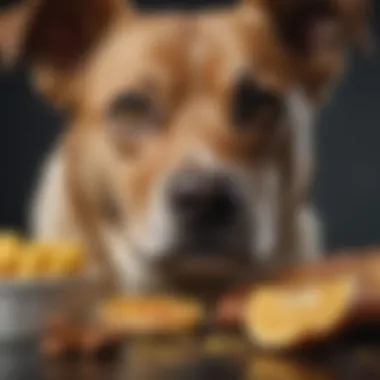Three Toxic Foods for Dogs: The Risks Every Owner Should Know


Intro
Dogs are often seen as a beloved part of the family. However, not all foods that humans consume are safe for these pets. Understanding which common foods pose risks is essential for every dog owner. This article will delve into three toxic foods for dogs, highlighting the dangers they possess, symptoms of ingestion, and safe dietary practices that can help protect canine health.
Fascinating Facts About the Animal
Unique Characteristics
Dogs have evolved alongside humans for thousands of years. They exhibit a remarkable range of sizes, appearances, and temperaments. With an acute sense of smell and hearing, they have instincts that often outmatch those of humans. Their adaptability to various environments shows their versatility as animals.
Extraordinary Abilities
Among their many talents, dogs possess an extraordinary ability to learn commands and tricks. Training methods have evolved, leading to strong bonds between dogs and their owners. This bond is critical when it comes to teaching safe eating habits. Training a dog not to eat harmful food can greatly reduce risks.
The Toxic Foods
Understanding specific foods is vital. Here are three common toxic foods to dogs:
Chocolate
Chocolate contains theobromine, which is toxic to dogs. Their metabolism does not break down this compound effectively. Symptoms of chocolate poisoning can vary based on the amount consumed, including vomiting, diarrhea, and increased heart rate. Dark chocolate and baking chocolate contain higher levels of theobromine, making them more dangerous.
Grapes and Raisins
Both grapes and raisins can lead to acute kidney failure in dogs. Even small quantities can be harmful. Symptoms such as vomiting, lethargy, and loss of appetite may arise within a few hours of ingestion. It is currently unclear why these fruits are toxic, but the effects can be severe.
Onions and Garlic
Onions and garlic belong to the Allium family. They can damage red blood cells in dogs, leading to anemia. Symptoms may not appear for several days after ingestion. Damage to red blood cells can cause lethargy, weakness, and even dark-colored urine.
It is crucial for dog owners to remain vigilant about what their pets consume. Knowing the risks associated with specific foods can prevent dangerous situations.
Symptoms of Ingestion
Immediate recognition of symptoms is essential. Common signs of food poisoning may include:
- Vomiting or diarrhea
- Lethargy
- Loss of appetite
- Abdominal pain
Recognizing these symptoms early can make a significant difference in outcomes. If any of these occur, contacting a veterinarian promptly is crucial.
Importance of Education
Educating pet owners about safe feeding practices is imperative. Understanding canine nutrition helps prevent accidental poisoning. A healthy diet tailored for dogs involves proper ingredients, avoiding foods that are known to be dangerous.
Intro to Dog Nutrition
Understanding dog nutrition is critical for the health and well-being of our canine companions. Dogs, unlike humans, have unique dietary needs that must be met to ensure their overall vitality. What we feed them directly influences their energy levels, immune responses, and long-term health. An essential aspect of responsible pet ownership is knowing what constitutes a safe diet.
Importance of Safe Food Choices
Dogs often explore the world using their mouths. This behavior can lead them to consume inappropriate or even dangerous foods. It is crucial for pet owners to be aware of which foods are safe and which pose a risk. Making safe food choices can help prevent adverse health outcomes, such as poisoning.
When selecting food for dogs, consideration includes not only the primary meals but also any potential snacks or treats. Educating oneself on harmful substances can reduce the chances of accidents. Awareness can ensure that both owners and dogs enjoy a harmonious living environment.


Impact of Human Foods on Canine Health
Humans frequently share their meals with dogs, often out of affection. However, not all human foods are safe for dogs. Certain common foods can lead to severe health complications. Examples include chocolate, onions, and grapes. These items can cause toxicity, with symptoms ranging from gastrointestinal distress to organ failure.
Conversely, some human foods can be beneficial and offer nutritional value to canines. For instance, lean meats and certain vegetables can enhance a dog’s diet. Thus, understanding which human foods are harmful versus those that contribute positively is vital. Regular consultations with veterinarians can help tailor a balanced diet that includes both safe human food and proper dog food formulations.
"Educating dog owners on nutritional safety not only improves the health of individual pets but also fosters a culture of responsible pet ownership."
Common Toxic Foods for Dogs
Understanding the potential risks associated with common foods toxic to dogs is essential for every pet owner. This aspect of canine nutrition necessitates awareness and education. Improper food choices can lead to serious health issues for dogs, including poisoning and long-term medical conditions. The dangers posed by certain human foods can sometimes be underestimated, leading to inadvertent ingestion by dogs.
Pet owners must recognize that dogs have different metabolic pathways than humans. What might be safe and delicious for us can be highly harmful to them. This section allows for a focused look into specific foods that pose significant toxicity risks to dogs and underscores the importance of informed dietary decisions.
Overview of Toxicities
The toxic component in foods like chocolate, onions, garlic, grapes, and raisins is crucial to understand. For example, chocolate contains theobromine and caffeine, both substances can be extremely dangerous for dogs.
- Theobromine Effects: Theobromine can lead to excitability, rapid heart rate, and potential seizures in dogs. The severity of symptoms varies based on the amount ingested and the dog's size. This means that small dogs can suffer even more significant effects from smaller amounts of chocolate.
- Caffeine Risks: Caffeine also poses risks similar to those of theobromine and can exacerbate the toxic effects when ingested in combination. Dogs exhibit signs like restlessness, increased heart rate, and gastrointestinal upset when exposed to caffeine.
Onions and garlic contain compounds that can be harmful as well. Thiosulfates in these foods cause oxidative damage to red blood cells in dogs. This leads to conditions like hemolytic anemia. Symptoms may not be immediately visible, which complicates timely intervention.
In terms of grapes and raisins, the specific toxic compound remains elusive. However, these foods can lead to acute kidney failure in dogs. Such a severe reaction may occur with only a small amount, making the situation more precarious.
The Role of Education in Preventing Ingestion
Education plays a vital role in preventing dog food poisoning caused by the consumption of toxic foods. It is essential for pet owners to educate themselves about what their pets can and cannot safely consume. Regularly informing household members on safe food practices can prevent accidental ingestion.
Key strategies include:
- Discussions on Safe Foods: Regularly talk about the dietary needs of dogs and share resources detailing safe versus harmful food. Promote safe alternatives, such as vegetables and fruits that are non-toxic.
- Supervision During Meal Times: Keep a close eye on your dog during family meals or gatherings. Ensure they do not have access to foods that are unsafe.
- Emergency Contacts: Familiarize yourself with local veterinarians’ contact numbers or local poison control. In case of an emergency, timely action is critical.
By prioritizing education and open communication, you can create a safer environment for your pet, lessening the risk of accidental poisoning.
Chocolate: The Hidden Danger
Chocolate is a beloved treat among many humans, but its effects on dogs are far from benign. Understanding the dangers of chocolate is essential for responsible pet ownership. This section will explore the chemical composition of chocolate, highlighting the dangers of its components—particularly theobromine and caffeine—along with the symptoms their ingestion can provoke.
Chemical Composition of Chocolate
Theobromine Effects
Theobromine is the primary toxic compound found in chocolate. Dogs metabolize theobromine much more slowly than humans, leading to toxic levels in their systems. Theobromine can stimulate the heart and central nervous system, increasing heart rate and causing anxiety. This response is particularly dangerous because it can escalate to severe health issues.
Key characteristics of theobromine include its presence in all types of chocolate, but concentrations vary. Dark chocolate contains significantly more theobromine than milk chocolate, making it more hazardous for canines. Understanding its role in chocolate toxicity is vital; if ingested in sufficient quantities, it can lead to lethal consequences for dogs. It's a major point of focus for this article as it elucidates why chocolate can hurt dogs.
Caffeine Risks
Caffeine is another methylxanthine compound found in chocolate, albeit in smaller amounts compared to theobromine. Similar to theobromine, caffeine can stimulate the nervous system and affect heart function. Ingestion can cause restlessness, rapid breathing, and elevated heart rate. While caffeine toxicity may not be as commonly associated with chocolate as theobromine, it still merits attention due to its potential impact.
The unique feature of caffeine risks lies in its comparable effects on both humans and dogs. When discussing chocolate dangers, educating pet owners on caffeine’s presence in various forms of chocolate is critical. Ignorance of this element can lead to serious health risks, enhancing the importance of understanding its implications for dogs.
Symptoms of Chocolate Poisoning
Vomiting and Diarrhea


Vomiting and diarrhea are common symptoms that occur after a dog ingests chocolate. These reactions are the body's way of trying to rid itself of the toxic substance. They can also serve as initial indicators of chocolate poisoning. Dogs may experience both vomiting and diarrhea concurrently, resulting in dehydration and further health complications.
The key characteristic of these symptoms is that they often appear early after ingestion. Their immediacy makes them valuable diagnostic cues for pet owners and veterinarians alike. Intervention becomes crucial at this stage, as letting these symptoms persist can lead to more severe health problems.
Hyperactivity and Tremors
Hyperactivity and tremors are other notable symptoms that highlight the dangers of chocolate consumption. The stimulation of the central nervous system due to theobromine can lead to abnormal levels of activity in dogs. Tremors can manifest as shaking or spasms, which can be distressing for both the dog and the owner.
This symptom set also serves as a critical warning sign. Identifying hyperactivity alongside tremors indicates potential chocolate poisoning. Such symptoms require immediate assessment from a veterinary professional, as they can lead to more serious outcomes if left unchecked.
What to Do in Case of Ingestion
If you suspect that your dog has ingested chocolate, acting quickly is essential. Promptly contacting a veterinarian or an emergency animal clinic can save your dog's life. Their guidance on next steps may include inducing vomiting or performing tests to assess the level of toxicity. Stay calm and provide as much information as possible about the type and amount of chocolate consumed, and the size of your dog. This will help in determining the appropriate treatment.
Understanding the hidden dangers of chocolate can ultimately contribute to a safer environment for dogs. Awareness and quick action can prevent serious health crises, underscoring the importance of ongoing education for pet owners.
Onions and Garlic: A Cautionary Tale
Onions and garlic are oftentimes staples in many households. Their flavors can enhance a wide range of dishes, but these common ingredients pose a serious risk to dogs. Understanding the toxic effects is important for dog owners who wish to protect their pets from potential harm. This section will delve into the mechanisms behind their toxicity, the symptoms to watch for, and ways to prevent accidental ingestion.
Mechanism of Toxicity
Thiosulfate Exposure
Thiosulfate is the primary harmful compound in onions and garlic that causes toxicity in dogs. Animals, unlike humans, lack the necessary enzyme that efficiently processes thiosulfate. The ingestion of even a small amount can lead to serious health issues. When thiosulfate accumulates in the system, it damages red blood cells, leading to hemolytic anemia in pets. Educating pet owners about this specific toxic compound is crucial as it directly contributes to the overall goal of preventing poisoning in canines. The critical characteristic of thiosulfate exposure is its insidious nature. It can be present in various forms, whether raw or cooked, which makes it important for everyone who handles food to be aware.
Oxidative Damage to Red Blood Cells
The oxidative damage caused by thiosulfate primarily affects red blood cells. This damage occurs when the red blood cells cannot withstand the oxidative stress, resulting in their premature destruction. This situation causes anemia, a significant concern for dog owners. Moreover, damaged cells may not provide sufficient oxygen to vital organs, leading to further complications. This unique aspect of oxidative damage highlights its severity in the context of canine health, making it a significant focus in this article. Understanding the dangers posed by oxidative stress can inform pet owners about the critical prevention methods they can adopt.
Symptoms of Onion and Garlic Toxicity
Signs of Anemia
Anemia presents itself through various indicators that should alert pet owners. Common signs include weakness, lethargy, and loss of appetite. In severe cases, dogs may show pale gums, rapid heart rate, and even behavioral changes. Understanding these symptoms allows for early detection and intervention. Early identification of anemia is essential in treatment, as it can prevent exacerbation of the pet’s condition. Recognizing and responding to these signs will ultimately contribute to better health outcomes for dogs exposed to these foods.
Gastrointestinal Distress
Gastrointestinal distress is another frequent symptom following the ingestion of onions and garlic. Symptoms may include vomiting, diarrhea, and abdominal pain. While these signs could be linked to other issues, the context of recent dietary habits will provide clarity. Gastrointestinal symptoms act as a crucial indicator for pet owners to consider; they reflect how well a dog can tolerate various foods. Understanding this relationship contributes to overall knowledge about canine health management.
Prevention and Safe Alternatives
Preventing accidental ingestion of onions and garlic is vital. Here are some practical strategies:
- Educate all household members: Ensure that everyone knows the dangers associated with these foods.
- Store food properly: Keep onions and garlic out of reach, including in cooking areas.
- Be cautious with leftovers: Many food scraps may contain harmful ingredients, so be vigilant.
Safe alternatives, such as carrots or green beans, can provide healthy snacks without the associated risks. Keeping a vigilant eye on what feeds your dog is essential for their well-being.
Understanding these aspects of onions and garlic can make a significant difference in responsible pet ownership.
Grapes and Raisins: An Unforeseen Threat
The introduction of grapes and raisins into discussions about dog health raises critical awareness among pet owners. Many people overlook these items as potential hazards. Grapes and raisins are widely used in various human foods, including snacks and baked goods. Hence, a dog ingesting them, even accidentally, can lead to severe health consequences. Recognizing the significance of this matter helps to mitigate those risks effectively. This section will focus on how grapes and raisins can harm dogs, emphasizing the importance of understanding these risks.
Potentially Kidnapping Kidney Function


The toxicity of grapes and raisins is particularly concerning because it can lead to sudden kidney failure in dogs. This mechanism is not entirely understood, which makes it even more perplexing. Unlike other toxic substances that may exhibit signs upon ingestion, grape toxicity's rapid progression into kidney damage poses a unique threat. While some dogs seem unaffected, others can face dire consequences. The broad range of reactions adds to the complexity of managing this risk, highlighting the necessity for vigilance in dog owners.
Symptoms of Grapes and Raisins Poisoning
Vomiting and Lethargy
Vomiting and lethargy are often the first signs that a dog might have consumed grapes or raisins. These symptoms serve as an early warning system that something is wrong. Vomiting result from the body trying to eliminate the toxin, while lethargy indicates that the dog is not feeling well and lacks energy.
Important to note, the combination of these symptoms typically prompts owners to seek veterinary assistance. They highlight the need for immediate attention. As a result, recognizing vomiting and lethargy is crucial for initiating the necessary response and preventing further complications.
Kidney Failure Indicators
Kidney failure indicators often appear after initial symptoms, making them a focal point in assessing health deterioration. Signs such as decreased appetite, increased thirst, and changes in urination habits can emerge in the wake of grapes or raisins consumption. The implications of kidney failure can be dire, making these indicators significant in understanding the overall health of a dog. Recognizing these symptoms early can make all the difference for recovery chances.
The Mystery of Individual Sensitivity
Individual sensitivity to grapes and raisins varies widely among dogs. What is toxic for one dog may not affect another. This inconsistency complicates risk assessments for pet owners and veterinary professionals. Such variability underlines the importance of being cautious with any foods that carry uncertainty regarding their safety for canine consumption. Each dog is unique, demanding a tailored approach in terms of diet and awareness of potential dangers. Owner education becomes paramount in ensuring that all dogs remain safe from the threats posed by these seemingly harmless snacks.
Understanding the risks associated with grapes and raisins is essential for responsible dog ownership. Awareness can protect your pet from potential harm.
Best Practices for Protecting Your Dog
Best practices for protecting your dog from toxic foods are essential part of responsible pet ownership. These practices help ensure a safe and healthy environment for our canine companions. Understanding these best practices can save lives and prevent distressing incidents.
Educating Your Household
Educating everyone in your household is a crucial step. All members must understand what foods are harmful. This awareness can prevent accidental ingestion of toxic items.
- Sharing Knowledge: Inform everyone about the specific foods listed in this article, like chocolate, onions, garlic, grapes, and raisins.
- Creating Guidelines: Establish clear guidelines about food sharing with your dog. Ensure family members know not to give human food to the dog under any circumstances.
- Visual Aids: Consider using posters or infographics that highlight toxic foods. Hanging these in common areas can serve as reminders.
Creating a Safe Eating Environment
A safe eating environment minimizes the risk of exposure to toxic foods. An organized setup is essential for your dog's wellbeing.
- Secure Storage: Store human foods out of reach. Keep items like chocolate and grapes in high cabinets or locked containers.
- Designated Eating Area: Create a specific area for your dog's meals. This area can reduce the temptation for snacking on human food when not supervised.
- Waste Management: Use secure trash cans. Dogs are often drawn to smells of discarded food. A secure bin will prevent them from scavenging through harmful leftovers.
Consulting Veterinary Professionals
Regular consultation with veterinary professionals is vital. Vets play an important role in your dog's health.
- Expert Advice: Veterinary professionals can provide the latest information on toxic foods and overall canine nutrition. They can guide on the safe food to give.
- Emergency Preparedness: Know the signs of toxicity. Understanding symptoms can help you act quickly in case of an emergency. Vets can offer clear instructions on steps to take if ingestion occurs.
- Regular Check-ups: Schedule frequent check-ups to make sure your dog is healthy. Regular visits help address any dietary concerns before they become serious problems.
Ensuring your dog’s safety regarding food toxicity requires attention and knowledge. Keeping yourself and your household informed can prevent dangerous situations.
Protecting your dog is a shared responsibility. By educating everyone, ensuring a safe eating environment, and consulting with professionals, you contribute to their long-term health.
The End
In summarizing the dangers of certain foods to dogs, it is critical to understand the gravity of this issue. Knowledge about toxic foods is not just valuable for individual pet care; it has wider implications for overall canine health within households. Keeping dogs safe from harmful substances helps diminish the risk of serious medical conditions and could potentially reduce emergency veterinary visits.
Recap of Toxic Foods
As discussed, three notable foods can pose severe hazards to dogs: chocolate, onions, garlic, and grapes and raisins. Each of these foods has distinct effects on canine health. Chocolate, with its theobromine content, can lead to symptoms ranging from gastrointestinal upset to cardiac issues. Onions and garlic contain thiosulfate, a compound that can damage red blood cells, causing anemia and other health complications. Lastly, grapes and raisins are linked to sudden kidney failure in dogs, with symptoms such as vomiting and lethargy being key indicators of ingestion.
By being aware of these toxic foods, owners can safeguard their pets effectively. Immediate action and recognition of symptoms can save lives.
The Importance of Ongoing Education
Pet ownership is a long-term commitment that comes with the responsibility of continually educating oneself about safe feeding practices. The landscape of canine nutrition is ever-changing, and updates in research may uncover new risks associated with human food. Therefore, staying informed through reliable sources ensures that pet owners can make educated decisions for their dogs' diets.
Reading articles, joining pet care forums, or consulting with veterinary professionals are essential steps in enhancing one’s knowledge. This effort promotes a culture of safety and awareness, which ultimately leads to healthier pets. After all, preventative measures can often outweigh reactive efforts in many aspects of pet health. >







